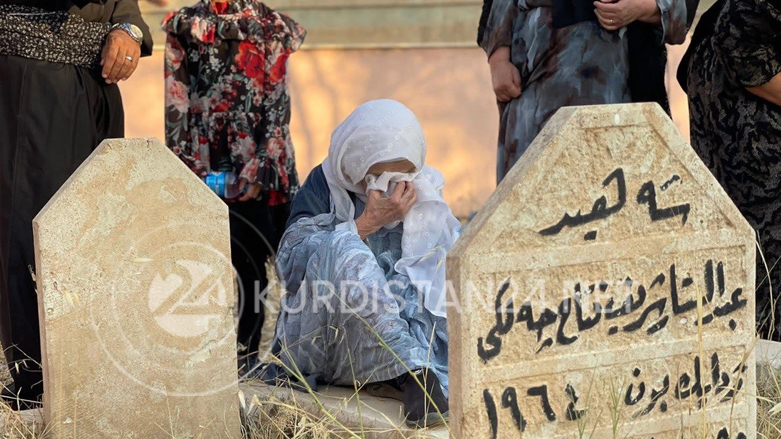Survivors of Bahdinan Anfal genocide commemorate 34th anniversary

Thirty-four years have passed since the genocide that was inflicted on the people of Duhok province by the Saddam Regime.
Even after thirty-four years, for Fakhir Tahir a survivor of the Anfal, the atrocities that took place on 28 of August 1988 is still recent in his mind.
Saddam Regime army attacked Kurema and Chalke villages in Mangesh sub-district north of Duhok in Kurdistan Region, killing 27 men.
According to Fakhir, on that day he was 11 years old, the Iraqi army captured villagers, segregating men, women, and children, they took him into men’s line twice and turned him back into lines of children knowing he won’t be shot.
Thirty-three men from our village Kurema and Chalke village were lined up and shot by the army, 27 men died while 6 of the men had the luck of staying stuck but alive beneath the bodies of the dead victims, soldiers were unaware that the 6 have survived.’ Said Fakhir.
The men who survived were, Ababakir Ali, Qahar Khaleel, Sidqi Abdulqader, Kareem Naif, and Hashim Muhammed, the other survivor’s name was Fatah Abdulqader, after coming out of the experience alive he escaped but was later captured again and his fate is unknown to this day.’ He continued.
After the shooting, the army left the location and no one dared to go and bury the bodies.

A while later the cleric of Mangesh went along with some men and performed a quick burial by throwing some soil over the body, in 1993 we went back and gave them a proper burial.
Fakhir goes on to tell of what happened to the villagers, saying that they were put into military trucks from the village heading to a school building in Mangesh, they spent two nights there, then they were trucked to Nizarke Fort where they put up with torture and starvation.
In Nizarke he tried to stay out of sight of troops as much as possible because one of his friends who was the same age as Fakhir was shot dead because he looked tall and had a more grown-up look.
Seven days later they were taken to Salamiya Fort.
Fakhir described the 18 days he spent in Salamiya as the longest 18 days in his life, later they were included in an amnesty and were released but sent to Bahrka Camp.
Fakhir has so many excruciating memories that he says no expression can articulate them all well enough.
In the seven days, they were in captivity in Nizarke fort, his father was killed by Iraqi troops using a concrete block right before the eyes of Tahir’s mother.
And his two-month-old sister died from malnourishment complications because there was no milk for her in the camp.
His only wish now is to know the exact grave of his father so he and his family can have some kind of closure.
Zahra Kuremay, another survivor of Anfal can’t help but cry on each Anfal anniversary when the victims are commemorated and she goes back into detail about those days.
In the summer of 1988, the army drove into our village, capturing all villagers that were present that day, they separated men from women and ordered us, women and children, to walk into military trucks.

We protested saying we can’t leave we need men to carry our children, but they demonstrated to us that they will follow soon after, they were speaking Arabic and we only speak Kurdish so we didn’t understand each other well.
My husband was in the line of men who we later realized were shot dead.
My son was asleep in my arms when my husband gently touched his back, he told me to take the children and go and not to worry, while I reluctantly walked away with my sister-in-law, he kept looking our way, which was the last time I saw him.
Just when we arrived at the military truck we heard gunshots, we cried saying you killed them, they lied saying that there has been an amnesty and that it is just celebratory shots.
I cried that my children won’t ever get to feel the love their father had for them.
The troops trucked us to the Mangesh school building that was transformed into a prison full of people, I was pregnant at the time, and affected by circumstances I suffered a miscarriage.
The Badinan Anfal started on Aug. 25, 1988, and continued until Sept. 6 that year. It is considered the fiercest stage of the murderous campaign.
The Nizarki Fort in Duhok city is a symbol of the Bahdinan Anfal genocide since it was where the former Baath regime systematically tortured and killed thousands of people.

